
Ladakh is a region in the Indian state of Jammu and Kashmir that currently extends from the Siachen Glacier in the Karakoram range to the main Great Himalayas to the south, inhabited by people of Indo-Aryan and Tibetan descent. It is one of the most sparsely populated regions in Jammu and Kashmir and its culture and history are closely related to that of Tibet. Ladakh is renowned for its remote mountain beauty and culture.

The Indo-Pakistani War of 1947–1948, sometimes known as the First Kashmir War, was fought between India and Pakistan over the princely state of Jammu and Kashmir from 1947 to 1948. It was the first of four Indo-Pakistan Wars fought between the two newly independent nations. Pakistan precipitated the war a few weeks after independence by launching tribal lashkar (militia) from Waziristan, in an effort to capture Kashmir, the future of which hung in the balance. The inconclusive result of the war still affects the geopolitics of both countries.
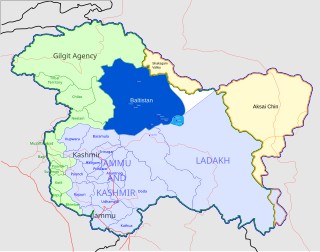
Baltistan (Urdu: بلتستان, Balti: སྦལ་ཏི་སྟཱན also known as Baltiyul or Little Tibet, is a mountainous region in Pakistan-administered Kashmir near the Karakoram mountains just south of K2. Baltistan borders Gilgit to the west, Xinjiang in the north, Ladakh on the southeast and the Kashmir Valley on the southwest. Its average altitude is over 3,350 metres.

The Kargil district is a district of Ladakh division in the Indian state of Jammu and Kashmir. It spans the entire length of the state in the north-south direction, with the Pakistan-administered region of Gilgit–Baltistan to the north, the Kashmir and Jammu divisions to the west, and the Leh district of the Ladakh division to the east. Zanskar is part of Kargil district along with Suru, Wakha and Dras valleys.
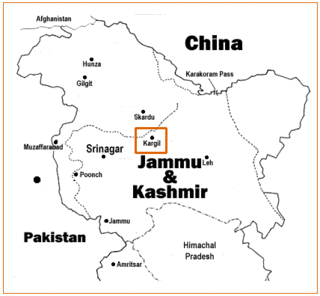
The Kargil War, also known as the Kargil conflict, was an armed conflict between India and Pakistan that took place between May and July 1999 in the Kargil district of Kashmir and elsewhere along the Line of Control (LOC). In India, the conflict is also referred to as Operation Vijay which was the name of the Indian operation to clear the Kargil sector.

11th Gorkha Rifles, abbreviated as "11 GR", is an infantry regiment of the Indian Army comprising Gurkha soldiers of Nepalese origin that was re-raised after independence. The regiment consists of primarily the Rais, Limbus and Sunuwar of eastern Nepal – mainly from Taplejung, Panchthar, Sankhuwasabha and Dhankuta districts. It also recruits from Indian Gorkhas and Bhutias from Darjeeling district, West Bengal and Sikkim. Though it is considered to be the youngest of the Gorkha regiments its lineage is as long as those of the 7th Gurkha Rifles and 10th Gurkha Rifles.

The 4th Gorkha Rifles or the Fourth Gorkha Rifles, abbreviated as 4 GR, is an infantry regiment of the Indian Army comprising Gurkha soldiers of Indian and Nepalese nationality, especially Magars and Gurungs hill tribes of Nepal. The Fourth Gorkha Rifles has five infantry battalions. The regiment was raised in 1857 as part of the British Indian Army. In 1947, after India's independence, the Fourth Gurkha Rifles became part of the Indian Army as the Fourth Gorkha Rifles.

The Indian Millitary Academy, Dehradun is the officer training Academy of the Indian Army. IMA was established in 1932.
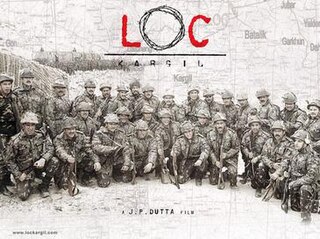
LOC Kargil is 2003 Indian historical war drama film based on the Kargil War fought between India and Pakistan, produced and directed by J. P. Dutta under his J.P. Films Banner. Featuring a large number of Bollywood stars and music composed by Aadesh Shrivastava and Anu Malik, with the former composing the score and the latter composing the songs. The film recorded as average returns at the box-office.

Udhampur is a district in the Indian state of Jammu and Kashmir(In Indian administrative Kashmir). It covers an area of 4,550 square kilometres (1,760 sq mi) in the Himalayan mountains, an area greater in size than the Emirate of Dubai. Udhampur town is the headquarters The Northern Command headquarters of the Indian Army is located in the district.
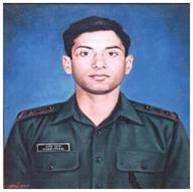
Lieutenant Manoj Kumar Pandey, PVC, was an Indian Army officer of the 1st battalion, 11 Gorkha Rifles who was posthumously awarded India's highest military honour, the Param Vir Chakra, for his audacious courage and leadership during the Kargil War in 1999. He was killed during the attack on Jubar Top, Khalubar Hills in Batalik Sector, Kargil. His actions have led to him being referred to as the "Hero of Batalik".

Zorawar Singh Kahluria (1786-1841) was a general of the Sikh Empire in the Indian Subcontinent. In reference to his legacy of conquests in the Himalaya Mountains including Ladakh, Tibet, Baltistan and Iskardu as General and Vizier. He has been referred to by historians as the "Conqueror of Ladakh" and the "Napoleon of India".

Dras is a town in the Kargil District of Indian state of Jammu and Kashmir on NH 1 between Zoji La pass and Kargil town. It is often called "The Gateway to Ladakh". The government of Jammu & Kashmir's official spelling of the town is Drass.
Major Mariappan Saravanan, was an officer in the prestigious Bihar Regiment of the Indian Army who was killed during the Kargil War. He was killed in hand-to-hand combat with intruders after killing four intruders in the Batalik area of Kargil Sector on 29 May 1999, along with 33 soldiers and four other officers. Saravanan had just completed four years of service on 10 March 1999.
Military operations took place in Ladakh in 1948 during the conflict in Jammu and Kashmir between the Indian Army and Pakistani raiders infiltrated to capture the kingdom of Jammu and Kashmir. The eviction of this invading force of tribal raiders, who enjoyed numerical superiority, better lines of communication, commanding high ground and superior logistics, was a major military achievement for the small force of Indian soldiers.
Colonel Sonam Wangchuk, MVC is an Indian Army veteran, who served with the Assam Regiment and the Ladakh Scouts. He was awarded the Maha Vir Chakra, India's second highest award for gallantry in the face of the enemy, during his successful operation in the Kargil War.

Colonel Lalit Rai, VrC is a former Indian Army officer who was decorated for his actions during the Kargil War in 1999. As the commanding officer (CO) of the 1st battalion, 11 Gorkha Rifles, he was tasked with capturing the strategic heights of Khalubar in the Batalik sector during the Kargil War.

Lieutenant General Yogesh Kumar Joshi, AVSM, VrC, SM is the 17th and the current Commander, XIV Corps of the Indian Army and assumed the post on 31 August 2018. He assumed the post from Lt General Santosh Kumar Upadhya.
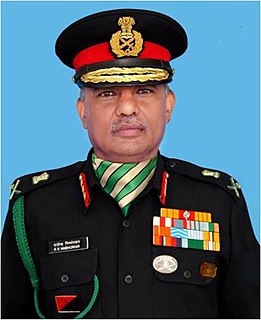
Lieutenant General Rajendra Ramrao Nimbhorkar, PVSM, UYSM, AVSM, SM**, VSM is a former officer of the Indian Army who served as the Master General Ordnance (MGO). He assumed office on 9 August 2017 after Lieutenant General Ravi Thodge retired. He was part of one of the strike corp which was responsible for carrying out three strikes inside POK in Surgical Strikes held in 2016 by the Indian Army to clean out all the Pakistani Terrorists Camps. As surgical strikes were carried out very secretly to maintain surprise, so very few people knew of them, one of those involved was Lt. Gen. Nimbhorkar. Terrorists numbering 55 were killed in this operation.
Major General Anant Singh Pathania MVC, MC was a decorated Indian Army general; the first Indian to receive a Military Cross in the Second World War, he was also the first Indian commanding officer of the Gorkha Rifles. During the Sino-Indian War of 1962, he commanded the 4th Infantry Division during a critical stage of the conflict, and was severely criticized for his poor generalship, which led to the complete collapse and defeat of his division without a fight.



















